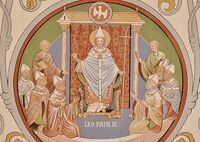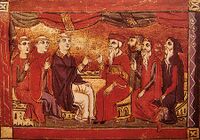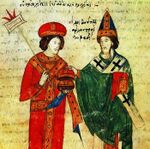Great Schism
The Great Schism was the final break-up between the Latin Catholic West and the Greek Orthodox East in 1054. It was a long time coming and broke the communion unity between these two brands of Christianity. There had been rows, stuff was thrown at the wall and people had died in earlier disputes, but like an unhappily married couple, both sides had ultimately patched up their differences ('for the sake of the kids'). However, this 1054 split was never healed and persists to this day. True, there were several attempts at 'reunion,' but these were so one-sided toward the Catholics that the Orthodox churches repudiated the 'agreements' and gave the Holy Finger at icons of the Pope.
Origins[edit]
Since the Council of Chalcedon back in the 5th century, Catholic and Orthodox had largely been allied with each other against the other flavours of Christian practise then flourishing. Arians, Nestorians and Monophysites had split away on the issue about how much divine/human Jesus had been. At the time, the Catholics and Orthodox agreed on the Messiah's theological biology. But by the 8th century, their fight was on how to worship as Christians. Iconoclasm had split the Greek East but had barely dented the Latin West.
Disagreement[edit]
Five main issues divided the two versions of Christianity:
| Greek | Latin |
|---|---|
| Razor blades are the work of the Devil. | Clean-shaven makes us stand out from the hairy Franks. |
| The Holy Spirit comes only direct from God. | No, he may detour via Jesus. |
| Communion requires fluffy bread. | God only likes pitta bread, as he is Jewish. |
| All of the ancient five Patriarchies are equal (Alexandra, Antioch, Constantinople, Jerusalem and Rome). | The Pope knows best. |
| You smell! (Greeks and Latins) to each other. | |
There were also minor issues, such as what colour undervestments to wear. The 'beard/shaven' rule was ignored by many Latin clergy too. The issue of smell was important. You can still sniff the difference whether you are in a Catholic or Orthodox church today. In Protestant churches, the smell is of caustic soda.
The breaking[edit]
The weird thing about the Great Schism was that it was at a time when Pope Leo IX was looking around for allies against the Normans. Originally a swords-for-hire outfit in Southern Italy, the Normans had worked for the Byzantines against the Lombards and Saracens until a dispute about wages led to a breaking of contracts. Pope Leo tried the Holy Roman Empire, but they were out hawking. Instead, Leo sent a delegation to Constantinople to meet emperor Constantine IX. To kill two birds with one stone, Leo suggested his team drop by and meet Patriarch Michael I to iron out a 'few theological niggles'. For his part Patriarch Michael wanted to know why the Holy See was shuttering Greek Orthodox religious houses in southern Italy.[1]
The head of the mission to Constantinople was Cardinal Humbert of Silva Candida. His instructions were to get help from Constantine and to kick Patriarch Michael until he recognised Rome's authority over all Christians, bar none. However, when Patriarch Michael brought up all the issues of contention between the two churches as listed above, Humbert flew into a rage. Michael excommunicated Humbert and all his supporters. Humbert counter-excommunicated Michael and stuck a very nasty note on the altar of the Hagia Sophia's church as he stormed out.[2]
Emperor Constantine tried to patch up matters and then received a message that Pope Leo had died, rendering Cardinal Humbert's actions 'invalid'. The Cardinal maintained that unless Michael apologised, he would not rescind his actions. Michael likewise refused to back down. Humbert returned to Rome.
Aftermath[edit]
Back in Italy, Humbert said the schism wasn't his fault; he had just been reminding the patriarch that the Pope was superior. It's likely he wrote a report and gave it to Pope Leo's successor, Pope Victor II — Well, he would have, but Victor was away in Northern Italy on other matters. When Victor died, his successor was Pope Stephen IX, who as Frederick of Lorriane had been part of the Pope Squad sent with Humbert to Constantinople. There would be no rescinding the excommunications until the Byzantine church blinked first. They didn't. The schism stood.
Going their separate ways[edit]
At first, nothing really changed. Patriarch Michael copied Rome's example and closed the churches that were operating on Western Christian Lines to match what happened earlier. This apparently made both sides equal. Each crossed the other off their Christmas card list. Relations between Rome and the emperors in Constantinople were maintained. There had been schisms in the past, some lasting a couple of decades before things got patched up. Not this time. The day for talking was over.[3] For now, they would officially ignore each other as much as possible. And they did — for next 911 years.
As for Humbert and Michael they would be dead pretty soon. Humbert is credited with changing the methods of electing a pope. Before 1059 the system had been a mix of popular approval (or who could bring out their supporters onto the streets of Rome) or being nominated and approved by an emperor since the days of emperor Constantine the Great. After 1059 the vote for pope was restricted to red hatted 'PAPA' cardinals. Patriarch Michael's fate was a bit more spectacular. Feeling powerful for telling the Latins to get stuffed, he meddled in Byzantine politics. Cerularius opposed empress Theodora for nominating as her successfor Michael VI and got him deposed in favour of another general who became emperor Isaac I. However, this didn't satisfy Cerularius who had imperial ambitions of his own. He was accused of sedition and treason and was exiled to an island to await trial. The old patriarch died before he could be tried.
References[edit]
- ↑ Patriarch Michael Cerularius — to give him his full name — was a bigot's bigot. He also hated women, especially the Byzantine empresses Zoe and Theodora.
- ↑ The contents were suitably childish from Humbert, whose friends called him 'Humpy'.
- ↑ To be fair to no one in particular, there were two attempts to re-unite the churches, in 1274 and 1439. Both were instigated by a Byzantine emperor looking for support from the West but both failed in short order.
See also[edit]
| Preceded by: Fourth Council of Constantinople (Catholic Church) and Fourth Council of Constantinople (Eastern Orthodox) |
Schisms 1054 |
Succeeded by: Reformation |





